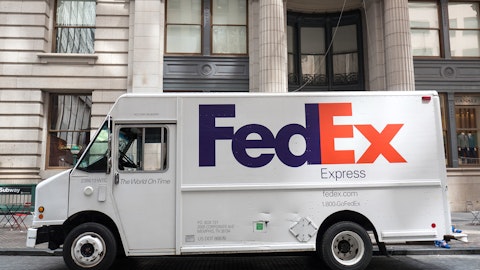Old Dominion Freight Line, Inc. (NASDAQ:ODFL) Q3 2023 Earnings Call Transcript October 25, 2023
Operator: Good morning, and welcome to the Old Dominion Freight Line Third Quarter 2023 Earnings Conference Call. All participants will be in a listen-only mode. [Operator Instructions] After today’s presentation, there will be an opportunity to ask questions. [Operator Instructions] Please note, this event is being recorded. I’d now like to turn the conference over to Drew Andersen, Investor Relations. Please go ahead.
Drew Andersen: Thank you. Good morning, and welcome to the third quarter 2023 conference call for Old Dominion Freight Line. Today’s call is being recorded and will be available for replay beginning today and through November 1, 2023, by dialing 1-877-344-7529, access code 8344351. The replay of the webcast may also be accessed for 30 days at the Company’s website. This conference call may contain forward-looking statements within the meaning of the Private Securities Litigation Reform Act of 1995, including statements, among others, regarding Old Dominion’s expected financial and operating performance. For this purpose, any statements made during this call that are not statements of historical fact may be deemed to be forward-looking statements.

A freight train making its way through a majestic mountain range, snow-capped peaks in the distance. Editorial photo for a financial news article. 8k. –ar 16:9
Without limiting the foregoing, the words believes, anticipates, plans, expects and similar expressions are intended to identify forward-looking statements. You are hereby cautioned that these statements may be affected by the important factors, among others, set forth in Old Dominion’s filings with the Securities and Exchange Commission and in this morning’s news release. And consequently, actual operations and results may differ materially from the results discussed in the forward-looking statements. The Company undertakes no obligation to publicly update any forward-looking statements, whether as a result of new information, future events or otherwise. As a final note, before we begin, we welcome your questions today, but we do ask in fairness to all that you please limit yourself to just one question at a time before returning to the queue.
Thank you for your cooperation. At this time, for opening remarks, I would like to turn the conference over to the Company’s President and Chief Executive Officer, Mr. Marty Freeman. Please go ahead, sir.
Kevin Freeman: Good morning, and welcome to our third quarter conference call. With me today on the call is Adam Satterfield, our CFO. After some brief remarks, we will be glad to take your questions. Old Dominion’s third quarter financial results reflect continued softness in the domestic economy. As a result, our shipment levels decreased on a year-over-year basis for the fifth straight quarter. Some encouraging trends developed during the quarter as our LTL shipments per day averaged 49,670 after averaging 47,077 per day for the first six months of the year. While a portion of this growth can be attributed to the loss of one large competitor, we believe we are winning new business from other carriers in the industry due to the quality of our service and overall value provided to our customers.
The OD team effectively responded to this positive inflection in volumes by continuing to offer superior service at a fair price. We were pleased that our on-time performance was 99% during the quarter while our cargo claims ratio was 0.1%. As we have said many times before, service means much more than just picking up and delivering to our customers freight on-time and claims free. There are many other attributes that shippers consider when selecting a carrier such as consistent transit times, carrier trustworthiness and ease of doing business. Mastio & Company conducts a comprehensive LTL study each year and they recently measured carriers on 28 different service and value-related attributes. Mastio published their 2023 results just this week and we are extremely proud to be named the number one national LTL provider for the 14th straight year.
Logistic professionals ranked OD as number one for 25 of the 28 individual attributes in the most recent survey, which was our best performance ever and demonstrates our unwavering commitment to excellence and customer satisfaction. We believe the consistency and quality of our service over many years has validated by Mastio has differentiated Old Dominion in the marketplace and supported our ability to win market share over the long-term. Our superior service also continues to support our ongoing yield management initiatives. We focus on obtaining consistent yield increases each year to offset our cost inflation and support our ongoing investments in capacity and technology. Maintaining excess capacity during slower economic environments comes at a cost, but we believe having an available capacity for customers when they need it the most is critical element for our value proposition.
As a result, we consistently invest in service center capacity, equipment, technology, and most importantly, our people. Because of these investments, we are well positioned to respond to the positive inflection in volumes during the quarter. It is important to note that while other carriers may have the ability to invest in service centers, equipment and technology, [indiscernible] family of employees that truly distinguishes us from our competition. We have a unique company culture that has defined who we are for a [indiscernible] for many years, delivering superior service at a fair price having a consistent approach to pricing and investing for growth may sound like a simple formula, but it takes a committed team to keep delivering on these fundamental elements for a long-term strategic plan.
The execution by our team and consistency in our long-term financial results gives us a continued confidence in our strategic plan. We remain committed to this plan and believe we are better positioned than any other carrier in our industry to win market share over the long-term. As we continue to deliver our unmatched value proposition to our customers over the long-term, we are confident that we can create further profitable growth and increase shareholder value. Thank you very much for joining us this morning, and now, Adam will discuss our third quarter financial results in greater detail.
Adam Satterfield: Thank you, Marty, and good morning. Old Dominion’s revenue decreased 5.5% in the third quarter of 2023 due to a 6.9% decrease in LTL tons per day that was partially offset by a 3.1% increase in LTL revenue per hundredweight. We also had one less operating day as compared to the third quarter 2022. The combination of this decrease in revenue and slight deterioration in our operating ratio contributed to the 8.0% decrease in earnings per diluted share to $3.09 for the quarter. On a sequential basis, revenue per day for the third quarter increased 8.9% when compared to the second quarter of 2023 with LTL tons per day increasing 3.6% and LTL shipments per day increasing 5.7%. For comparison, the 10-year average sequential change for these metrics includes an increase of 2.9% in revenue per day, an increase of 0.7% in tons per day, and an increase of 1.8% in shipments per day.
As Marty just mentioned, a portion of this increase can be attributed to the loss of one large competitor as underlying demand has remained relatively consistent throughout the quarter. We do believe, however, that we are also winning new business from other carriers in the industry due to the quality of our service and overall value provided to our customers. The monthly sequential changes in LTL tons per day during the third quarter were as follows: July decreased 1.5% as compared with June, August increased 4.7% versus July and September increased 2.7% as compared to August. The 10-year average change for the respective months is a decrease of 3.1% in July, an increase of 0.1% in August and an increase of 3.6% in September. For October, we expect our revenue per day will increase by approximately 1.5% to 2% when compared to October 2022, with a decrease of approximately 2% to 2.5% in our LTL tons per day.
While our shipment levels for the month have been stronger than our normal sequential trend, we believe a portion of this outperformance is attributable to a cybersecurity incident disclosed by a competitor. We would expect some of the incremental growth in October will return to that competitor in November. As usual, we will provide actual revenue related details for October in our third quarter Form 10-Q. Our third quarter operating ratio increased 150 basis points to 70.6% as the increase in overhead cost as a percent of revenue more than offset the improvement in our direct cost. While the decreasing revenue had a deleveraging effect on our cost categories that are more fixed in nature, we were pleased with the increase in operating efficiencies that helped drive the improvement in our direct cost.
We also continued with our best efforts to control discretionary spending to minimize the increase in overhead expenses as a percent of revenue. We did, however, continue to execute on our 2023 capital expenditure plan to help ensure that we have the necessary capacity for anticipated growth once the domestic economy improves. This resulted in a 110 basis point increase in our depreciation expenses as a percent of revenue. That, along with the increase in employee benefit cost largely contributed to the overall increase in overhead expenses. Old Dominion’s cash flow from operations totaled $429.2 million and $1.1 billion for the third quarter and first nine months of 2023, respectively. While capital expenditures were $172 million and $651.4 million for the same periods.
We utilized $65.9 million and $368.1 million of cash for our share repurchase program during the third quarter and first nine months of 2023, respectively. While cash dividends totaled $43.7 million and $131.5 million for the same periods, our effective tax rate for the third quarter 2023 was 24.0% as compared to 23.9% in the third quarter 2022. We currently anticipate our effective tax rate to be 25.6% for the fourth quarter. This concludes our prepared remarks this morning. Operator, we will be happy to open the floor for questions at this time.
See also 20 Countries that Produce the Most Motor Vehicles in 2023 and 25 Highest Paying Jobs for Stay-at-Home Moms.
Q&A Session
Follow Old Dominion Freight Line Inc. (NASDAQ:ODFL)
Follow Old Dominion Freight Line Inc. (NASDAQ:ODFL)
Operator: We will now begin the question-and-answer session. [Operator Instructions] Our first question is from Allison Poliniak with Wells Fargo. Please go ahead.
Allison Poliniak: Hi. Good morning. Could you talk a little bit about the density improvement that you saw in the network? And any way to quantify that? And then maybe following that, just touch on how much excess capacity you have in the system today to take on some more volumes? Thanks.
Adam Satterfield: Sure. Our current level of excess capacity, which is in our service center network is now between 25% to 30%. We did improve density within our operations during the quarter and that was a big factor in driving the improvement in our direct operating costs, at least the improvement that we saw both sequentially and on a year-over-year basis. But we leverage that inflection in the volumes and we always say long-term improvement in the operating ratio was driven by two key factors; density and yield and both generally support – or require the support of a macro economic environment is positive, but we had good leverage there that drove some nice operating efficiencies within our pickup delivery operations on the dock as well had improvement.
We still had a slight decrease in our linehaul load factor, but that’s improved from where we were earlier in the year. So all those factors contributed to the improvement in our direct cost as a percent of revenue during the quarter.
Allison Poliniak: Great. Thanks for the color.
Operator: The next question is from Jack Atkins with Stephens. Please go ahead.
Jack Atkins: Okay. Great. Good morning, and thanks for taking my question. So I guess, Adam, as you think about the sequential progression into the fourth quarter, I know there are a lot of puts and takes with October and the disruption – the further disruption of the market in October. But could you maybe talk about your expectation for – or maybe how we should be thinking about operating ratio trends sequentially from the third quarter to the fourth quarter, all things considered?
Adam Satterfield: Sure. Typically, the fourth quarter operating ratio is 200 basis points to 250 basis points worse than the third quarter. A couple of factors drive that. Usually, revenues a little bit softer. We give our wage increase the first of September, so we get three, four months within the quarter with that new wage rate, but multiple factors that generally are driving that change. One thing to note, we also do an actuarial assessment each year, we conduct that in the fourth quarter, and we normalize for that, just to assume it stays flat with the previous quarter, but we’ve seen adjustments in the past. That can be favorable, which is what we had last year as well as unfavorable. So assuming those costs stay different, I think that we can be in the 150 basis point to 200 basis point deterioration range, so slightly better than what we would historically see.
Some of that, we’re obviously starting the quarter out with a little favorability versus our normal sequential trend as we discussed. And so I think that we expect some volumes to kind of normalize, if you will, back to where they otherwise would have been for November and December. But that still gives us a little bit of a head start, and I think will help us drive a little bit of outperformance versus our normal trend there.
Jack Atkins: Okay. Makes sense. Thanks for the time.
Operator: The next question is from Ravi Shanker with Morgan Stanley. Please go ahead.
Ravi Shanker: Great. Good morning, everyone. So just maybe a 2024 question, if you will. It looks like yourselves and maybe a lot of the big LTLs still have a fair bit of excess capacity in their network even after absorbing the yellow volumes. I’m wondering how you think the kind of – how numbers will play out when the upcycle comes. Do you expect to see the market has suddenly tightened up and there to be like a rising tide of pricing? Or do you just think that you get better incremental margins as the volumes come in? Kind of where do you think the 2024 upcycle looks like in a post Yellow situation at this point?
Adam Satterfield: Well, I think it’s yet to be determined for 2024. Certainly, there’s a lot of tea leaves that would suggest this could be a year of inflection. But we also believe the same thing we thought we were going to see a rebound in the spring of this year, so we’re cautiously optimistic about what next year may bring. As we’ve said before, with the post Yellow situation, we want to be measured with our approach and continue to believe that slow and steady wins the race. So we didn’t try to go out and immediately win as much share as was out there in the market, but we’re trying to do it in the right way in leveraging the capacity that we have and not just the capacity and the service in the network, there’s a people capacity element as well as equipment.
And I don’t know that there’s as much capacity in the market, as you may have indicated with your question because we’re hearing it every day. We’re hearing about competitors that are missing pickups. They don’t have the people part of the capacity equation solved and maybe took on too much freight and are starting to have negative implications from their overall service products. So we believe that we’ll continue to win market share, but do it in the right way by giving superior service at a fair price to our customers and offering a value that’s unmatched in our industry. And if we get some positive economic support, I think that you’ve seen in past cycles when we actually get there, 2018 and 2021 are good examples where we try to stay ahead of the growth curve with the capacity investments that we consistently make to be able to take on that volume when it’s there.
And when we look at those two years that I just referenced, we significantly outgrew the markets in those years despite the strength in underlying demand because of that excess capacity that we had in place.
Ravi Shanker: Great. Thanks, Adam.
Operator: The next question is from Chris Wetherbee with Citigroup. Please go ahead.
Christian Wetherbee: Hey, thanks. Good morning, guys. Maybe I could piggyback on that a little bit. As we think about 2024, I know normally you guys talk about costs. You talked about price sort of relative to cost and be able to need to exceed that in any sort of normal year. I guess in post Yellow, as you think about 2024, do we need to see something else to be able to sort of spark a better-than-normal pricing year for you guys in 2024? I think there are expectations that next year naturally would be because of what happened with Yellow. But is a normal cyclical recovery enough to spark something that would be better than average? I just want to get your sort of general take on how sort of spring loaded or not you think the pricing environment is?
Adam Satterfield: Yes, sure. Well, I think the environment continues to be strong overall, especially given the supply shock that happened. But I think our approach is different from many of our competitors. We believe in a long-term consistent approach to pricing. And we try to target obtaining 100 basis points to 150 basis points of price above cost each year. We’ve had some cost pressure this year, and that’s evident in our numbers. But I believe that, that starts improving as we go into next year, especially if we can get a little bit of volume recovery. We’re already seeing the core inflation in our business moderating. It did in the third quarter. And I think that same trend can carry through in 4Q and into 2024 as well.
But I think the market should certainly be conducive to us being able to obtain the increases that we believe we need to justify and cover our cost inflation, but also the investments that we’re making in capacity. We’re only a carrier that’s really investing significantly in service center capacity. We’ve invested $2 billion over the last 10 years. And as a result, we’ve been able to increase our door capacity by 50%. And when you look at the public LTL companies at least, which are 65% to 70% of the market, overall capacity there is down close to 10%. And so I think that customers understand that and continue to give us the increases that we need that basically support the value proposition that we’re able to offer them. When you think about the supply chain challenges and whatnot that shippers have had to work through over the last couple of years, in particular, capacity hasn’t necessarily been at the forefront of the conversation over the last year, but over the last three, and it certainly has been critical.




